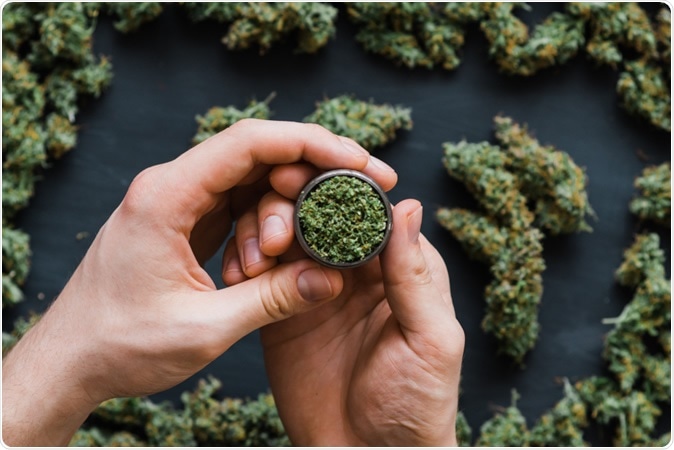A new study published in the journal American Journal of Psychiatry reports that the use of cannabis for non-medical indications is much more common in adults who have pain than in others. This includes those who use marijuana very often or heavily enough to be considered to have a problem with dependence.
What is marijuana?
Marijuana is the term used for the dried leaves, flowers, stems and seeds of the Cannabis sativa or Cannabis indica plants. These are used as mind-altering drugs due to components such as tetrahydrocannabinol (THC), which have profound psychological effects. Marijuana is currently the Number 1 psychotropic drug, and only alcohol is more commonly used. Many young people, including students in middle and high school, are using marijuana, and it is becoming a substance used in e-cigarettes as well.

Image Credit: Lifestyle discover / Shutterstock
Marijuana can now be used for medical or recreational purposes in 34 and 11 states of the USA, respectively. However, many papers have reported that using large doses of cannabis can heighten the risk of vehicle accidents, mental symptoms, breathing distress and cannabis use disorder, like addiction. Nonetheless, cannabis is still considered to be a harmless drug and many people use it without a medical indication almost every day. In particular, more students today say they think regular use of marijuana is not a risky act.
Effects of marijuana
Marijuana smoking produces both short-term and long-term effects. THC from smoke quickly enters the blood, reaches the brain and other organs, and acts on endocannabinoid receptors. These are receptors that are designed to react to natural substances which act like THC and are important in the natural growth and development of the brain. When marijuana is ingested, the effects are delayed in onset, generally seen after 30 minutes to an hour.
THC activates brain regions with the highest number of these receptors, causing the person to feel a high, as well as to experience more vivid sensations, mood changes, difficulties with movement and cognitive processing (thinking, judgment, memory and logic), hallucinations and delusions. Frank psychosis, or mental imbalance, can also occur and is most likely if the individual is on highly potent preparations of marijuana on a regular basis.
The long-term effects include impaired brain development. If the drug is first begun in adolescence, the developing brain is vulnerable to impairments of cognition, causing difficulties with learning, memory and thinking. It seems to affect the nerve connections that are normally grown between the different brain regions that act together to execute these complex tasks. It is still unclear if these changes are transitory or persist over time.
Other problems include respiratory difficulties due to lung irritation, a higher heart rate, lower fetal weight as well as a higher risk for poor brain and behavioral development if the drug is used in pregnancy, and intense vomiting.
The study
The purpose of this study was to find out what factors drove the risk of cannabis addiction. The researchers drew data from the National Epidemiologic Surveys on Alcohol and Related Conditions in 2001-2002 and 2012-2013, related to the use of cannabis. They looked at the patterns of use for non-medical reasons in adults, both those who had and those who did not have pain.
The findings
The study shows that about 20% of individuals in either survey said they had pain of moderate to severe degree. The use of non-medical marijuana went up to almost 10% in 2013, from 4% in 2002. The scientists also observed that the increase in frequency was significantly skewed towards patients with pain compared to those without, at 5% vs 3.5%. The same was the case with the risk of addiction, which occurred in over 4% in those with pain but in less than 3% in those without it.
The researchers point out the paradox that most meta-analyses of the efficacy of cannabis in the treatment of pain show mixed results, even while 2 out of 3 American adults believe that it helps significantly to manage one’s pain. In view of the fact that about a fifth of the adult population has moderate to severe pain, the number of adults who are at risk for cannabis addiction because of their non-medical use of the drug is very high. It should be noted that marijuana preparations available today are steadily becoming more potent compared to earlier times, which is one factor behind the increasing number of emergency room visits following the use of this drug. The regular use of high-potency cannabis also increases the risk that the person will become addicted and also the risk of psychosis.
The solution
The study authors recommend a balanced reporting about the effects of marijuana and the issues associated with its use. Says researcher Deborah Hasin, “Greater balance is needed in media reporting of marijuana issues, including messages that convey credible information about the nature and magnitude of health risks from non-medical cannabis use, including among the large group of US adults with pain. Psychiatrists and other mental health professionals treating patients with pain should monitor their patients for signs and symptoms of cannabis use disorder.”
Journal reference:
U.S. Adults With Pain, A Group Increasingly Vulnerable to Nonmedical Cannabis Use and Cannabis Use Disorder: 2001–2002 and 2012–2013 Deborah S. Hasin, Dvora Shmulewitz, Magdalena Cerdá, Katherine M. Keyes, Mark Olfson, Aaron L. Sarvet, and Melanie M. Wall American Journal of Psychiatry, https://ajp.psychiatryonline.org/doi/10.1176/appi.ajp.2019.19030284